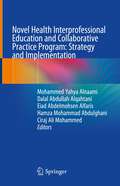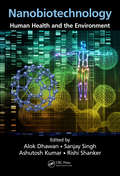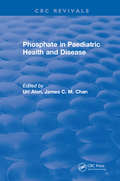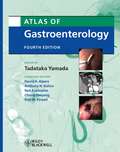- Table View
- List View
Formalin-Fixed Paraffin-Embedded Tissues: Methods and Protocols (Methods in Molecular Biology #724)
by Fahd Al-MullaPresenting an area of research that intersects with and integrates diverse disciplines, including genomics, epigenetics, proteomics, and cellular biology, among others, Formalin-Fixed Paraffin-Embedded Tissues: Methods and Protocols collects contributions from expert researchers in order to provide practical guidelines to this complex study. Compiled in order to provide researchers with up-to-date methodological information pertaining to the utilization of genomic, transcriptomic, and proteomic data in diagnosis, prognosis, and tailored therapy, the ultimate aim of this volume is to decipher diseases at a molecular level. Divided into multiple convenient chapters, this detailed book covers various techniques to construct and utilize tissue arrays, it also provides detailed protocols in immunohistochemistry, immunofluorescence, fluorescent and chromogenic in situ hybridization, and ultimately introduces protocols for FFPET microdissection and nucleic acids extraction for their utilization in advanced techniques such as microarray CGH, DNA methylation and pyrosequencing. The volume also discusses FFPET research from an ethical standpoint and concludes with a chapter on novel tissue fixative. Written in the highly successful Methods in Molecular Biology™ series format, chapters contain introductions to their respective topics, lists of the necessary materials and reagents, step-by-step, readily reproducible laboratory protocols, and notes on troubleshooting and avoiding known pitfalls. Authoritative and accessible, Formalin-Fixed Paraffin-Embedded Tissues: Methods and Protocols serves as a practical guide for scientists of all backgrounds and aims to convey the appropriate sense of fascination associated with this vital field of research.
Novel Health Interprofessional Education and Collaborative Practice Program: Strategy and Implementation
by Mohammed Yahya Alnaami Dalal Abdullah Alqahtani Eiad Abdelmohsen Alfaris Hamza Mohammad Abdulghani Ciraj Ali MohammedThis book describes a novel health interprofessional education and collaborative practice (IPECP) program established at King Saud University (KSU), Riyadh, Kingdom of Saudi Arabia. The book has three main sections. The first section introduces interprofessional education's background, theory, and context for collaborative practice. This section elaborates on defining and developing centers of excellence in IPECP, defining and exploring the meaning of interprofessional collaborative practice in contemporary health care, theories of the team working relevant to health and social care systems, and learning in and about interprofessional groups and broader collaboration. The second section explains how to formulate and implement strategies for effective IPECP. It involves developing and implementing a novel health IPECP curriculum, governance, IPECP's impact and implications on health care outcomes, IPE accreditation standards, regulatory policies, and legal structures. The third section describes the result of a case study of an IPECP program established at KSU. This program is developed by the vice-rectorship for health specialties at KSU (VRHS-KSU) in collaboration with partners harvard medical international (PHMI) to enhance health professional education further through interprofessional education and collaboration. For that purpose, a strategic plan is developed to develop learning, teaching, and assessment in all health sciences colleges (HSCs), along with a governance structure to establish a joint "center of excellence in interprofessional education and collaborative practice (CoE-IPECP)". The strategic plan and design of the program summarized in this book were accomplished through several meetings, workshops, and courses conducted at KSU in Riyadh, and harvard macy institute (HMI) in Boston, USA. The toolkit for successful program implementation includes a pro forma business plan, implementation groups' training, matching needs with feasibility, and expected impact on HSCs. Initiation of pilot projects started with implementing some interprofessional courses, establishing an initial physical and IT infrastructure of the center, developing the webpage, newsletter, and listservs, and improving faculty development programs to enhance IPECP at HSCs. Also, this book is a helpful road map for other national and international universities and institutes aiming to develop their professional health education, particularly interprofessional education and collaborative practice.
Trauma - An Engineering Analysis: With Medical Case Studies Investigation
by Y.F. Al-Obaid F.N. Bangash T. BangashA number of books and research papers have been published on trauma and biomechanics.Theyhavesofarnotbeenrealisticallyintegrated.Thebasicaim ofthisbookistopresentauni?edapproachbetweentheengineeringandm- ical professions. The available engineering analyses and mathematical models can be interlinked and glued together with the medical ?ndings by means of surgeries and X-rays/scans. They can be translated into vastly developed computer programs predicting e?ects of plasticity, temperature, cracking, and crushing with and without muscles and other interlocking phenomenon. The available mathematical-cum-engineering model on trauma and bone mechanics are then linked to the ?nite element analysis and to a computer programinwhichprovisionsaremadetocaterforallpossibleeventualitiesand medicalparameters.Theproblemencounteredbysurgeriescanbeeasilybe- corporated into hybrid ?nite element computer programs such as PROGRAM ISOPARusedinthisbook.Inallcasestudiesthesurgicalin?uenceshavebeen considered together with the bone material data for both the operational, nonoperational and overloading behaviour of the human body structure. In all circumstances the human body structure and its important elements were treated as composite. The bone–blood interaction has been incorporated in ordertoobtainrealisticsolutions.Materialpropertiesinthree-dimensionhave always been considered in throughout in various investigations. Engineering analysis of trauma is being continuously developed taking into consideration the ever increasing changes in analytical, design, safety, and manufacturing techniques. The engineering advances in that direction are steadily gaining international acceptance in the wide sense of the medical profession.
Genotoxicity Assessment: Methods and Protocols (Methods in Molecular Biology #1044)
by Alok Dhawan and Mahima BajpayeeGenetic toxicology is recognized by geneticists and researchers concerned with the genetic impact of man-made chemicals. In Genotoxicity Assessment: Methods and Protocols, expert researchers in the field provide comprehensive genetic toxicology protocols. These include in vitro and in vivo protocols on mutation assays, cytogenetic techniques, and primary DNA damage, assays in alternate to animal models, and updated ICH guidelines. Written in the highly successful Methods in Molecular Biology series format, the chapters include introductions to their respective topics, lists of the necessary materials and reagents, step-by-step and readily reproducible laboratory protocols, as well as key tips on troubleshooting and avoiding known pitfalls.Authoritative and cutting-edge, Genotoxicity Assessment: Methods and Protocols seeks to aid research students and scientists working in regulatory toxicology as well as biomedical, biochemical and pharmaceutical sciences.
Nanobiotechnology: Human Health and the Environment
by Alok Dhawan, Sanjay Singh, Ashutosh Kumar and Rishi ShankerThis book combines the contributions from the experts of material science, molecular biology, toxicology bio-organic and bio-inorganic chemistry, toxicologists and environmental and food technology etc. to fathom the full scope of current and future of developments in the area of Nanobiotechnology. Provides brief overview of nanobiotechnology for general readers who are not familiar with the research fields and presents a strong overview of most of the critical areas in field This book can also be used as text book for graduate students as an essential reference material, and as an reading material for general readers having a curiosity in Nanobiotechnology.
Phosphate in Paediatric Health and Disease
by U. AlonPhosphate in Pediatric Health and Disease provides a state-of-the-art overview of normal physiology, pathophysiology, genetics, clinical and therapeutic aspects of different types of phosphate homeostasis in early life. The book reviews the developmental physiology of phosphate metabolism from the fetus to the adolescent. It describes the pathophysiologic mechanisms associated with perturbations in phosphate homeostasis as well as discusses the different clinical conditions related to abnormal mineral metabolism, parathyroid hormone and vitamin D in infancy, childhood, and adolescence, and the modern diagnostic and therapeutic modalities. This book will benefit pediatricians, endocrinologists, neurologists, nutritionists, and researchers in the field of mineral metabolism.
Phosphate in Paediatric Health and Disease
by U. AlonPhosphate in Pediatric Health and Disease provides a state-of-the-art overview of normal physiology, pathophysiology, genetics, clinical and therapeutic aspects of different types of phosphate homeostasis in early life. The book reviews the developmental physiology of phosphate metabolism from the fetus to the adolescent. It describes the pathophysiologic mechanisms associated with perturbations in phosphate homeostasis as well as discusses the different clinical conditions related to abnormal mineral metabolism, parathyroid hormone and vitamin D in infancy, childhood, and adolescence, and the modern diagnostic and therapeutic modalities. This book will benefit pediatricians, endocrinologists, neurologists, nutritionists, and researchers in the field of mineral metabolism.
Systems Medicine: Physiological Circuits and the Dynamics of Disease (Chapman & Hall/CRC Computational Biology Series)
by Uri AlonWhy do we get certain diseases, whereas other diseases do not exist? In this book, Alon, one of the founders of systems biology, builds a foundation for systems medicine. Starting from basic laws, the book derives why physiological circuits are built the way they are. The circuits have fragilities that explain specific diseases and offer new strategies to treat them. By the end, the reader will be able to use simple and powerful mathematical models to describe physiological circuits. The book explores, in three parts, hormone circuits, immune circuits, and aging and age-related disease. It culminates in a periodic table of diseases. Alon writes in a style accessible to a broad range of readers - undergraduates, graduates, or researchers from computational or biological backgrounds. The level of math is friendly and the math can even be bypassed altogether. For instructors and readers who want to go deeper, the book includes dozens of exercises that have been rigorously tested in the classroom
Systems Medicine: Physiological Circuits and the Dynamics of Disease (Chapman & Hall/CRC Computational Biology Series)
by Uri AlonWhy do we get certain diseases, whereas other diseases do not exist? In this book, Alon, one of the founders of systems biology, builds a foundation for systems medicine. Starting from basic laws, the book derives why physiological circuits are built the way they are. The circuits have fragilities that explain specific diseases and offer new strategies to treat them. By the end, the reader will be able to use simple and powerful mathematical models to describe physiological circuits. The book explores, in three parts, hormone circuits, immune circuits, and aging and age-related disease. It culminates in a periodic table of diseases. Alon writes in a style accessible to a broad range of readers - undergraduates, graduates, or researchers from computational or biological backgrounds. The level of math is friendly and the math can even be bypassed altogether. For instructors and readers who want to go deeper, the book includes dozens of exercises that have been rigorously tested in the classroom
Molecular Aspects of Papovaviruses (Developments in Molecular Virology #9)
by Y. AloniIt is almost twenty years since the first DNA tumor virus meeting was held at Cold Spring Harbor. At this meeting studies on three tumor viruses were discussed: the papovaviruses, the adenoviruses and the herpesviruses. The present series Developments in Molecular Virology chose to reverse this sequence by first publishing books on the herpesviruses, followed by adenoviruses, and only now the papo vaviruses. All the DNA tumor viruses gained their original reputation by serving as model systems in animal cells for studying gene expression and gene regulation, but SV40 and polyoma have been the jewel in the crown in these studies, as A phage was for the study of prokaryotes. SV40 was the first DNA tumor virus to be completely sequenced that enabled the definition of the cis controlling elements in DNA replication and transcription. I am continuously fascinated by the organization of the SV40 and polyoma genomes. Although they contain about 5000 bp that encode for only 6 to 7 proteins, the mechanisms which regulated their gene expression are varied and include almost any other type of gene regulation found today to regulate eukaryotic genes. Just to mention two: (i) the early promoter is a classical promoter that contains the TAT A, CAAT and enhancer elements, while the late promoter is devoid of these elements, and (ii) the mRNA can be structurally and functionally monocistronic or dicistronic. This hints at the versatility in the control of gene expression at the transcriptional and translational levels.
DNA Electrophoresis Protocols for Forensic Genetics (Methods in Molecular Biology #830)
by Antonio AlonsoForensic DNA profiling procedures are mainly based on high resolution and high throughput capillary electrophoresis separation and detection systems of PCR amplicons obtained from DNA genomic markers with different inheritance patterns. In DNA Electrophoresis Protocols for Forensic Genetics, expert researchers in the field detail many of the protocols and methods which are now commonly used to perform forensic DNA profiling. It includes protocols for profiling of autosomal STRs, Y-STRs, X-STRs, autosomal SNPs, INDELS, Y-SNPs, mtDNA-SNPs, and mtDNA hypervariable regions HV1 and HV2 . Protocols for molecular identification of non-human species and mRNA profiling for body fluid identification are also included. Written in the highly successful Methods in Molecular Biology™ series format, chapters include introductions to their respective topics, lists of the necessary materials and reagents, step-by-step, readily reproducible laboratory protocols, and key tips on troubleshooting and avoiding known pitfalls.
Applied Surrogate Endpoint Evaluation Methods with SAS and R (Chapman & Hall/CRC Biostatistics Series)
by Ariel Alonso Theophile Bigirumurame Tomasz Burzykowski Marc Buyse Geert Molenberghs Leacky Muchene Nolen Joy Perualila Ziv Shkedy Wim Van der ElstAn important factor that affects the duration, complexity and cost of a clinical trial is the endpoint used to study the treatment’s efficacy. When a true endpoint is difficult to use because of such factors as long follow-up times or prohibitive cost, it is sometimes possible to use a surrogate endpoint that can be measured in a more convenient or cost-effective way. This book focuses on the use of surrogate endpoint evaluation methods in practice, using SAS and R.
Applied Surrogate Endpoint Evaluation Methods with SAS and R (Chapman & Hall/CRC Biostatistics Series)
by Ariel Alonso Theophile Bigirumurame Tomasz Burzykowski Marc Buyse Geert Molenberghs Leacky Muchene Nolen Joy Perualila Ziv Shkedy Wim Van der ElstAn important factor that affects the duration, complexity and cost of a clinical trial is the endpoint used to study the treatment’s efficacy. When a true endpoint is difficult to use because of such factors as long follow-up times or prohibitive cost, it is sometimes possible to use a surrogate endpoint that can be measured in a more convenient or cost-effective way. This book focuses on the use of surrogate endpoint evaluation methods in practice, using SAS and R.
Viruses and Apoptosis (Progress in Molecular and Subcellular Biology #36)
by Covadonga AlonsoUsing different viral models, molecular pathways regulated by viral genes and their role in the pathogenesis of infection are analyzed. The book also offers an update of known signaling pathways in apoptosis and their role in normal and infected cells. Special emphasis is given to molecular pathways underlying viral transformation and oncogenesis and how research in this area is opening opportunities in cancer therapy.
Nano-Oncologicals: New Targeting and Delivery Approaches (Advances in Delivery Science and Technology)
by Maria José Alonso Marcos Garcia-FuentesThis authoritative volume focuses on emerging technologies in cancer nano medicine, characterized by their multi-functionality and potential to address simultaneously diverse issues of clinical relevance in the treatment of cancer. The book consists of sixteen chapters divided into six sections: 1) Biological Barriers in Cancer; 2) Tumor Targeting; 3) Targeting the Immune System; 4) Gene Therapy; 5) Nano theranostics and 6) Translational Aspects of Nano-Oncologicals. The volume starts with an introduction describing the biological barriers associated with cancer therapy and highlighting ways to overcome such barriers through the use of nanotechnology. This is followed by an analysis of the two major targeting strategies currently under investigation in cancer therapy: namely, the targeting of cancer cells and the targeting of the immune system. In the first case, the book presents liposomal and polymer-based therapies, including photodynamic approaches. In the second case, it analyzes in detail the possibility of either improving the efficiency of the immune system toward preventing cancer progression (cancer immunomodulation) or generating responses against specific cancer antigens (cancer vaccines).Beyond these targeting options, Nano-Oncologicals: New Targeting and Delivery Approaches presents the most recent technological advances in the area of nucleic acid-based therapies, along with those in the area of theranostics, where the design of multifunctional nano carriers becomes vital. Following the study of the most promising nanotechnologies around the development of nano-oncologicals, the book ends with an overview of regulatory and toxicological issues, which are critical in their translational pathway, and the presentation of a nucleic acid-based therapy case-study. This book is an important resource for scientists interested in the design and development of anticancer nanotechnologies and also to those aiming to push their technology through clinical development.
Cleft Lip and Palate Treatment: A Comprehensive Guide
by Nivaldo Alonso Cassio Eduardo Raposo-AmaralThe aim of this book is to discuss cleft lip and palate deformities in a comprehensive way, presenting it from the basics to the most clinically and surgically relevant issues. First, the basic concepts of embryology and pathogenesis of the facial deformities will be discussed. Special attention will be paid to the genetics underlying this condition. Following that, basic principles of surgical treatment through the most recent advances in the field will be presented, along with most important evidences from the literature and the personal experience of the editors and authors. Cleft Lip and Palate Treatment presents the state of the art and advances in the field and is intended to serve as a comprehensive guide for a broad audience. All the specialties involved in the comprehensive care of these craniofacial deformities will be presented in this book.
Facial Reconstruction of Unusual Facial Clefts: A Guide to Diagnosis and Treatment
by Nivaldo Alonso Renato da Silva Freitas Cristiano Tonello Philippe PellerinFacial cleft is one of the most common congenital anomalies while atypical facial clefts are rare, with an incidence of 1.43 and 4.85 in 100,000 births. This book is dedicated exclusively to the diagnosis and treatment of rare facial clefts. It provides a comprehensive review of clinical aspects and surgical approaches used in unusual facial clefts and associated syndromes. Moreover, presents different classifications and surgical techniques, reflecting the authors extensive experience with a broad cross-section of treated patients. The rich illustrations and computed tomography images allows a broad view, helping the reader to understand the conduct in complex cases.Facial Reconstruction of Unusual Facial Clefts is an indispensable reference for all healthcare professionals involved in the multidisciplinary treatment of patients with craniofacial anomalies.
Advancing Health and Well-Being: Using Evidence and Collaboration to Achieve Health Equity (Culture of Health)
by Alonzo L . Plough, PHD, MPH, MAThe case for evidence and collaboration in pursuit of health equity In this second volume of the Culture of Health series, Advancing Health and Well-Being convenes experts from academia, policy, journalism, and community-based organizations, among other sectors, to examine how data and narrative can catalyze progress toward building a national Culture of Health. Tackling topics such as health inequity, mass incarceration, and climate change, Advancing Health and Well-Being does more than draw lines between cause and effect; its 70+ voices lend context and lived experience to critical conversations that may lack such elements. The result is a work that shows the power and promise of evidence and collaboration. Amid continued interest in population health and well-being, this book offers essential reading for those advancing such efforts, and those seeking an early grounding, in pursuit of a Culture of Health.
Study Surgery: A Guidance to Pass the Board Clinical Exam
by Haifa AlotaibiThe book provides A-Z information of surgical disorders in a concise and engaging format and serves as a complete reference for surgical trainees to prepare for the annual promotion and final clinical board exam specially the oral exam. It enhances the subject knowledge and provides distilled information required for clinical exams. The book teaches the resident how to approach a patient with a particular complaint, covering all the possible diagnoses, the operative techniques, and the post-operative follow up. The book provides evidenced based up-to-date information on the examination references in a very simple way. It includes algorithms and illustrations that provide better understanding and eliminate common areas of confusion that result in misdiagnosis and mismanagement; it focuses on the areas in which candidates commonly fail during the exams. Every chapter includes a practice section that provides the opportunity to practice learning outcomes in the form of multiple case scenarios and questions for discussion, along with ideal answers against which readers can test their knowledge using the provided checklist. These case scenarios are very interesting and unique asset of this book. The book is useful for surgical trainees and graduate students, who are preparing for their surgery board clinical exam. It may also be beneficial to the surgeons who have just qualified and passed their board, particularly who are in the early part of their professional career.
Chirurgische Intensivmedizin: Kompendium für die Praxis
by Alexander AloyIntensivmedizin erfordert rasche therapeutische Maßnahmen ohne Fehler und Unsicherheiten. Der Autor bietet Ärzten schnelle und übersichtliche Hilfe zur kompetenten Betreuung eines breiten Patientenspektrums auf einer chirurgischen Intensivstation. Er behandelt häufige Krankheitsbilder aus Abdominal-, Thorax- und Herzchirurgie, Traumatologie, Geburtshilfe und Innerer Medizin. Praxisnah vermittelt er grundlegende Kenntnisse in Bezug auf künstliche Beatmung, alternative Techniken und (par)enterale Ernährung. Besonderes Augenmerk widmet er Krankheitsbildern wie Sepsis mit ihrer Pathophysiologie (Verzahnung von Gerinnung und Inflammation).
Jet-Ventilation: Technische Grundlagen und klinische Anwendungen
by Alexander Aloy Eva SchraglDas vorliegende Buch stellt erstmals das gesamte Spektrum der normo- und hochfrequenten Jet-Ventilation dar. Nach der Darstellung der experimentellen Grundlagen und Überlegungen zum Wirkungsmechanismus werden die einzelnen Formen der Jet-Ventilation, die Applikationsmöglichkeiten und die gebräuchlichen Jet-Respiratoren im Detail beschrieben. Der zweite Teil des Buches behandelt die klinischen Einsatzmöglichkeiten der Jet-Beatmung, sowohl intraoperativ (mikrolaryngeale- und Thoraxchirurgie, Bronchoskopie und Stentimplantation) als auch in der Intensiv- und Notfallmedizin. Ein eigenes Kapitel ist dem Einsatz in der Pädiatrie gewidmet. Es wird weiters auf das Monitoring eingegangen, hämodynamische Auswirkungen, mögliche Komplikationen und die Grenzen der Jet-Ventilation werden kritisch beleuchtet.
Atlas of Gastroenterology
by David H. Alpers Anthony N. Kalloo Neil Kaplowitz Chung Owyang Don W. PowellAccurate, high-quality images are especially vital for gastrointestinal therapy. The Atlas of Gastroenterology is a gold-standard tool that provides specialists with an outstanding array of images covering all facets of the field. With endoscopic ultrasonographs, computed tomography scans, magnetic resonance images, radionuclide images, and angiograms demonstrating every clinical condition from liver abscess, to endocrine neoplasms of the pancreas, to motility disorders of the esophagus, this atlas is simply a must-own resource for all gastroenterologists. Showing the range of the newest imaging technologies and incorporating over 1700 full-color images, this new edition is an ideal teaching tool, and the perfect companion to the Textbook of Gastroenterology.
Principles of Clinical Gastroenterology
by David H. Alpers Anthony N. Kalloo Neil Kaplowitz Chung Owyang Don W. PowellA Concise, Symptom-Based Textbook for Diagnosis and Decision Making in Clinical Practice Over the past twenty years, thousands of physicians have come to depend on Yamada’s Textbook of Gastroenterology. Its encyclopaedic discussion of the basic science underlying gastrointestinal and liver diseases as well as the many diagnostic and therapeutic modalities available to the patients who suffer from them was—and still is—beyond compare. This new textbook, Principles of Clinical Gastroenterology, is designed to inform practitioners on the features of the major clinical disorders in gastroenterology and hepatology from the point of view of the clinician observing signs and symptoms of a patient under care and management. It is a practical guide to diagnosis and decision making in clinical practice and provides a rich source of information on diseases of the gastrointestinal tract and liver. Covering the full range of examinations in gastroenterology and hepatology, with extremely timely chapters on patients with dyspepsia, eating disorders, jaundice, hepatitis, cirrhosis, and on screening, Principles of Clinical Gastroenterology gives you easy access to approaches that a clinician might take to common symptoms and signs presented by patients with such disorders. The chapters include the epidemiology, history, signs and symptoms, diagnosis, treatment, and prognosis of the most commonly encountered disorders in gastroenterology and hepatology. This textbook will be an invaluable resource whether you are a gastroenterologist, internist, surgeon, or other clinician who sees patients with gastrointestinal and liver disorders. It should be kept close at hand for frequent consultation.





















